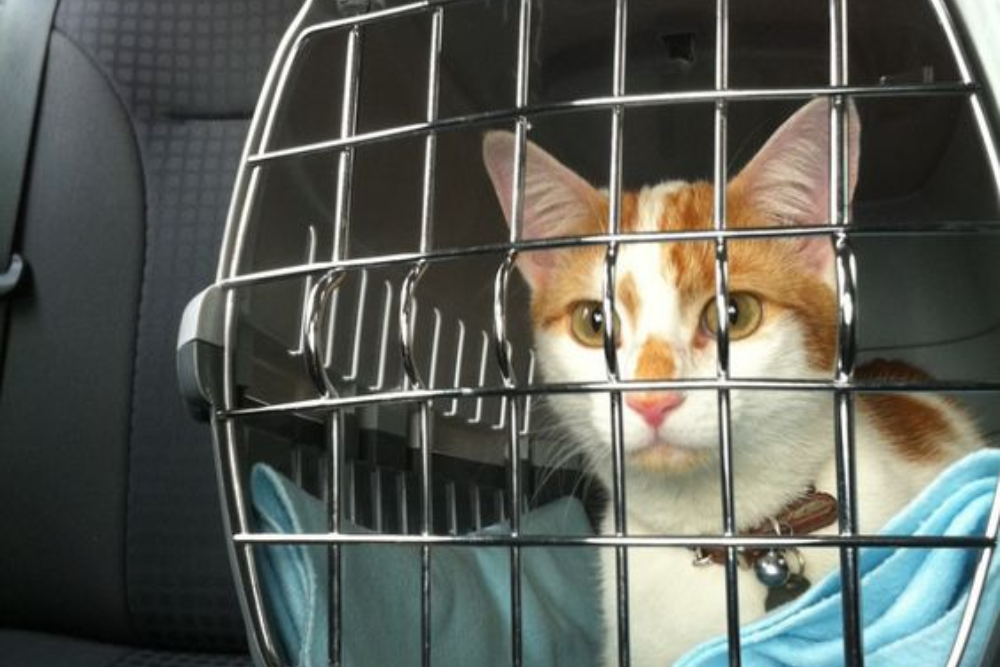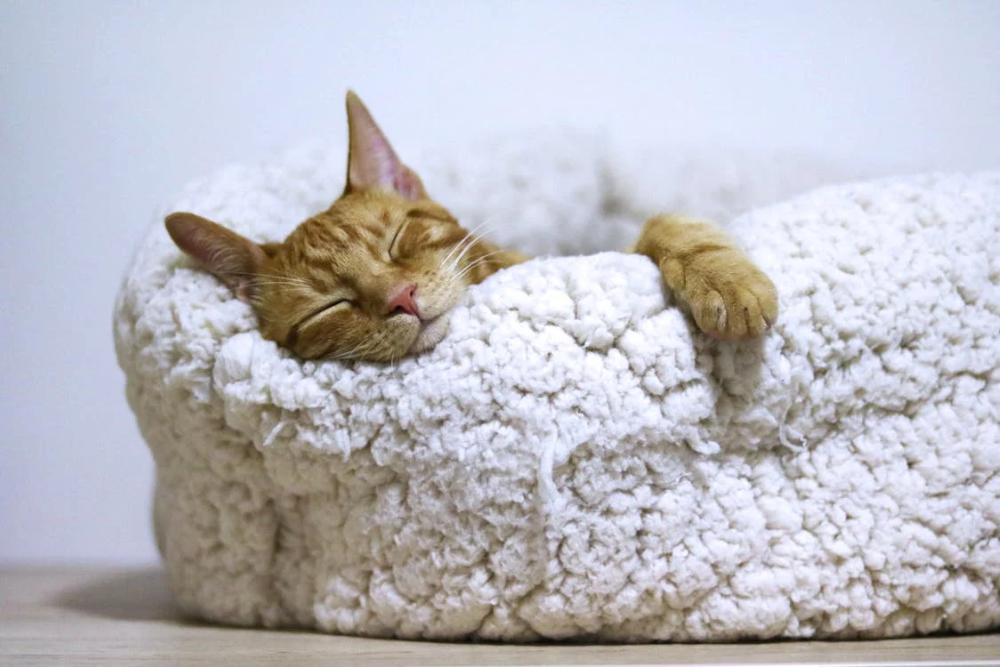Have you ever wondered how long a cat can stay in a crate? It’s like figuring out the right time for your furry friend to be in a special box. We want to be good cat caretakers, right? So, let’s explore and find out how we can keep our cats safe and happy in their crates. A crate, often made of plastic or metal, serves as a confined space for various purposes, from transportation to temporary containment. For cat owners, it’s essential to delve into the intricacies of cat crate utilization to ensure the well-being of their furry friends.
This article will help us understand how long can a cat Stay in a Crate and how we can take good care of them. Let’s get started on this cat adventure!
What is a Cat Crate?
A crate is a special and versatile space designed for our feline friends. It’s not just any box; it’s a cozy sanctuary made from materials like plastic or metal. Think of it as a cat’s haven, a bit like their own private room. These crates come in different shapes and sizes, offering a secure and comfortable environment for our beloved cats.
Cats use crates for various purposes. When it’s time for a journey, a crate becomes their safe travel companion, ensuring they stay snug and secure. At home, a crate serves as a quiet retreat, a place where cats can relax and feel protected. Picture it as a combination of a bedroom and a secret hideaway filled with all the things that make a cat happy – soft blankets, favorite toys, and sometimes even a little bowl of food.
So, in essence, a crate is more than just a box; it’s a magical space tailored to meet the needs of our furry friends, providing them with a sense of security, comfort, and a cozy spot they can call their own.
How Long Can a Cat Stay in a Crate? A Comprehensive Guide
When considering how long a cat can stay in a crate, it’s essential to follow expert recommendations for the well-being of your feline companion. Most experts suggest a maximum duration of around 6 hours for a cat to be confined in a crate. Beyond this time, certain precautions need to be taken to ensure your cat’s comfort and health.
After 6 hours, it becomes crucial to take your cat out of the crate for bathroom breaks. Cats, like humans, need to relieve themselves, whether it’s for urination or defecation. Additionally, this break provides an opportunity for your cat to stretch its legs, move around, and maintain physical well-being.
If you plan on keeping your cat in a crate for a longer duration, you must ensure that there are ample supplies inside. This includes having enough food and water accessible within the crate, allowing your cat to feed and hydrate independently. Placing a litter box inside the crate is also recommended to provide a designated and comfortable space for your cat to attend to its bathroom needs.
Creating a comfortable environment within the crate is crucial for your cat’s well-being. Consider the crate as a safe and cozy space by adding familiar items such as a soft blanket, toys, or a comfortable bed. Ensure proper ventilation within the crate, and be mindful of the temperature to prevent it from becoming too hot or too cold.
Monitoring your cat’s behavior during crate time is essential. Pay attention to signs of stress or discomfort, such as vocalization, pacing, or agitation. If your cat displays these signs, it might be an indication that the crate time needs to be shortened or adjusted to better suit your cat’s comfort.
When introducing your cat to crate time, do it gradually. Start with short durations and increase them as your cat becomes more accustomed to the crate environment. Positive reinforcement, such as treats and praise, can help create positive associations with the crate, making it a more welcoming space for your cat.
Planning for extended crate time requires careful consideration. If you anticipate needing to crate your cat for more than 6 hours, ensure that the crate is spacious enough for your cat to move around comfortably. Regular breaks and interactions with your cat during longer crate durations are essential for maintaining their mental and physical well-being.
Why Cats Shouldn’t Stay in Their Crates for Extended Period of Time
Cats, known for their playful and independent nature, thrive in environments that allow them freedom of movement and mental stimulation. While crates serve essential purposes such as transportation and temporary confinement, subjecting a cat to extended periods within one can have detrimental effects on their physical and mental well-being. Let’s delve into the reasons why keeping a mischievous and active kitty in a crate for an extended period is ill-advised.
1. Fear, Frustration, and Boredom:
Extended crate confinement induces fear, frustration, boredom, stress, and anxiety in cats. These emotions stem from the innate need for exploration and mental stimulation that a confined space cannot fulfill. Cats are natural hunters and explorers, and limiting their space can lead to a range of negative emotions.
2. Signs of Distress:
a. Intense Vocalization: Cats communicate through vocalization, and intense meowing or yowling during extended crate stays is a clear expression of their distress. It signifies their displeasure and a strong desire for freedom.
b. Pacing: Restless pacing within the confines of a crate is an indication of a cat’s discomfort. The constant movement reflects their attempt to cope with the restricted space, showcasing their innate need for physical activity.
c. Urinating/Defecating: Stress-induced inappropriate elimination, like urinating or defecating inside the crate, is a prominent sign of distress. Cats prefer clean spaces for elimination, and this behavior is a direct response to the emotional strain of confinement.
d. Trying to Escape: Cats are skilled escape artists, and when confined for too long, they may resort to desperate attempts to break free. Persistent efforts to escape the crate signal a strong desire for autonomy.
e. Salivating: Excessive salivation is a physiological response to stress and anxiety. Cats may drool when subjected to extended periods of confinement, highlighting the adverse impact on their mental state.
f. Rapid Continuous Movement: Restlessness, manifested as rapid and continuous movement, is a visible expression of a cat’s agitation. The inability to settle due to the restricted environment results in constant movement as a means of coping.
3. Physical Health Implications:
Extended crate stays can have significant physical repercussions on a cat’s health. Lack of movement can lead to muscle atrophy, joint stiffness, and weight gain. Additionally, the stress induced by prolonged confinement may compromise the cat’s immune system, making them more susceptible to illnesses.
4. Behavioral Issues:
Cats subjected to extended crate stays may develop behavioral issues that persist even outside the crate. Aggression, anxiety, and destructive behavior may manifest as a result of the stress accumulated during confinement. Addressing these behavioral challenges can prove challenging, requiring patience and positive reinforcement.
5. Alternatives to Extended Crating:
Responsible cat ownership involves providing alternatives to extended crating. If temporary confinement is necessary, ensure it is coupled with regular breaks for exercise, mental stimulation, and social interaction. Creating a designated cat-friendly space within your home, complete with scratching posts, toys, and comfortable resting spots, allows your cat to express natural behaviors freely.
Understanding the potential repercussions of prolonged crate stays is essential for cat owners. By recognizing the signs of distress and prioritizing the mental and physical well-being of their feline companions, responsible owners can make informed decisions that foster a healthy and happy environment for their beloved cats. Extended crate stays should be approached cautiously, with a focus on providing ample opportunities for exploration, play, and mental stimulation.
Crate Training Tips for Cats: A Step-by-Step Guide to Feline Comfort
Crate training is a valuable skill that can make various situations, from travel to veterinary visits, less stressful for both you and your feline companion. Here’s a detailed guide to ensure successful crate training for your cat:
1. Start Early for Optimal Acceptance:
Initiating crate training during your cat’s kittenhood lays the foundation for a positive association with the crate. Kittens are generally more adaptable, making the process less stressful for them. Gradual introduction during early stages ensures a lifelong positive outlook on crate usage.
2. Proper Crate Size Matters:
Choosing the right crate size is crucial for your cat’s comfort. Ensure the crate is large enough for your cat to stand up, turn around, and lie down comfortably. It should also have space for essentials like food, water, and a litter box. Sufficient space reduces stress and promotes a positive attitude toward crate usage.
3. Airline Travel Considerations:
If you plan to travel with your cat by air, familiarize yourself with airline-specific crate requirements. Airlines often have specific dimensions and materials for travel crates. Adhering to these guidelines ensures a smooth and safe travel experience for your feline friend.
4. Thoughtful Crate Selection:
Opt for a crate that is easy to take apart and features multiple entrances. This design facilitates stress-free entry and exit for your cat, reducing anxiety associated with confinement. A well-chosen crate simplifies the overall experience, making it more enjoyable for both you and your cat.
5. Create a Pleasant Environment Inside the Crate:
Enhance the appeal of the crate by transforming it into a comfortable and inviting space. Place familiar items such as toys and a cozy blanket inside the crate. The scent of these familiar items helps create a positive association, making the crate a pleasant and secure space for your cat.
6. Positive Reinforcement is Key:
Associate the crate with positive experiences by rewarding your cat every time they willingly enter. Use treats and praise to create a positive connection with the crate. Positive reinforcement builds trust and makes the crate a place of comfort rather than confinement.
7. Patience and Observation:
Crate training requires patience and careful observation of your cat’s reactions. Avoid forcing your cat into the crate, as this can create fear and resistance. Gradually increase the duration of crate stays, ensuring your cat remains calm and relaxed. Observe their reactions and adjust the training pace accordingly.
8. Avoid Forced Confinement:
Forcing your cat to stay in the crate against their will is counterproductive. It induces fear and stress, making the crate a source of anxiety rather than a safe space. Be patient and allow your cat to enter voluntarily, ensuring a positive association with the crate.
Remember, patience, positive reinforcement, and careful observation are key elements for successful crate training, fostering a bond of trust between you and your feline companion.
Responsible crate usage involves understanding the individual needs of the cat. While crates serve practical purposes, owners must prioritize their feline companions’ mental and physical well-being. Balancing safety, comfort, and positive associations is key to fostering a healthy relationship between cats and their crates.
Your Questions Answered
Can I Leave My Cat in a Crate?
Leaving your cat in a crate for an extended period is not recommended. Cats are naturally active and curious animals and prolonged confinement can lead to boredom, stress, and anxiety. It is crucial to provide your cat with mental stimulation, physical activity, and opportunities to explore their environment. If you need to use a crate, ensure it is for short durations and always accompanied by breaks for your cat to stretch, play, and engage in their natural behaviors.
How Long Can a Cat Live in a Cage? (6 hours at most)
While every cat is unique, it’s generally advised not to keep a cat in a cage for more than 6 hours at a time. Extended periods of confinement can lead to physical discomfort, stress, and behavioral issues. Cats require regular movement, mental stimulation, and access to essentials like food, water, and a litter box. If temporary confinement is necessary, it’s essential to provide breaks and ensure the cat’s overall well-being is prioritized.
Can I Crate My Cat for the Entire Day?
Extended crate time is not recommended. Cats need mental stimulation and physical activity. Prolonged confinement can lead to stress and behavioral issues. If crating is necessary, ensure regular breaks for your cat to engage in natural behaviors.
How Do I Know If My Cat Is Stressed in a Crate?
Signs of stress in a crate include intense vocalization, pacing, attempts to escape, and changes in behavior. Observing your cat’s reactions and addressing signs of distress promptly is essential for their well-being.
Are There Specific Crates for Airline Travel?
Yes, airlines have specific requirements for travel crates. Choose a crate that meets their guidelines to ensure a safe and comfortable journey for your cat.
Can Crate Training Start with Adult Cats?
While it may take more patience, adult cats can be crate-trained gradually with positive reinforcement. Start by associating the crate with positive experiences and take small steps to increase their comfort level over time.
Should I Leave Food and Water in the Crate?
Yes, it’s essential to equip the crate with food, water, and a litter box for extended confinement. Ensuring your cat’s basic needs are met contributes to their overall comfort and well-being.
Is It OK to Crate a Cat at Night?
Crating a cat at night can be acceptable for short durations if done correctly. Ensure the crate is comfortable, and provide familiar items. Gradual introduction and positive reinforcement help create a positive association with nighttime crating. However, it’s crucial to balance crating with ample free-roaming time during the day.
How Long Can a Cat Be Kept in a Carrier?
A cat can be kept in a carrier for short periods, such as during travel or vet visits. However, extended confinement should be avoided. Ensure the carrier is well-ventilated, comfortable, and equipped with essentials like food and water for longer journeys. Regular breaks are essential to address your cat’s physical and emotional needs.


